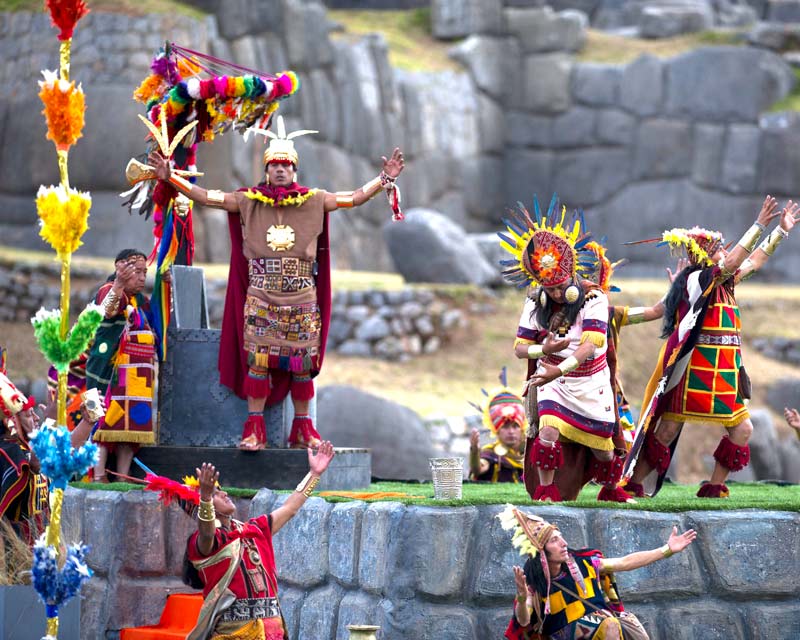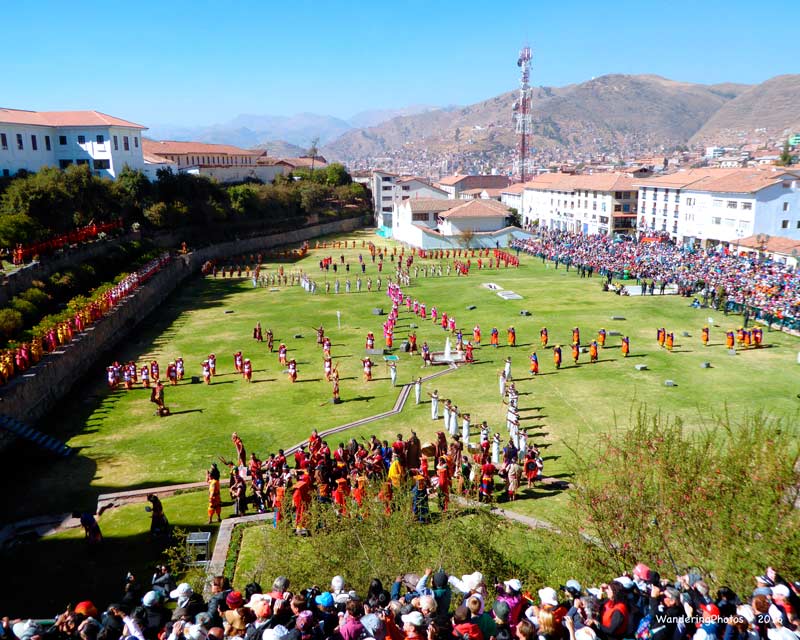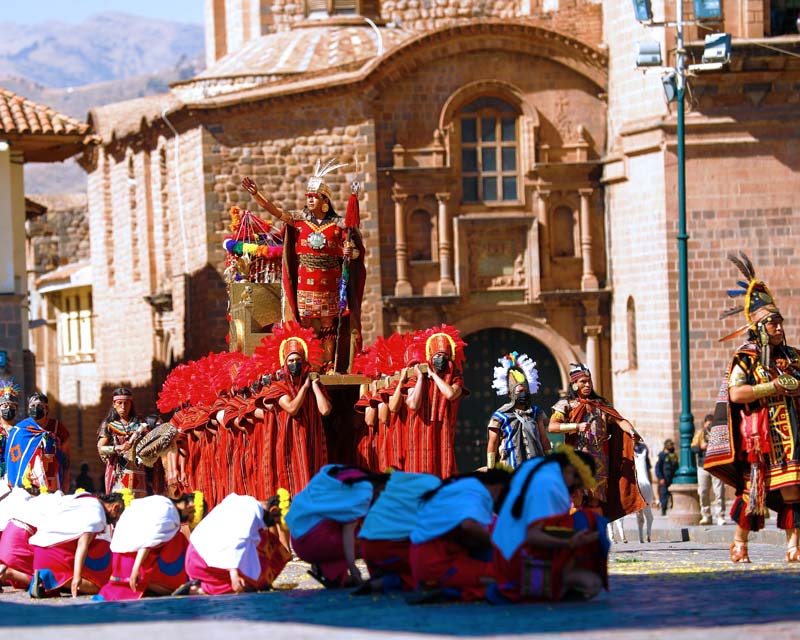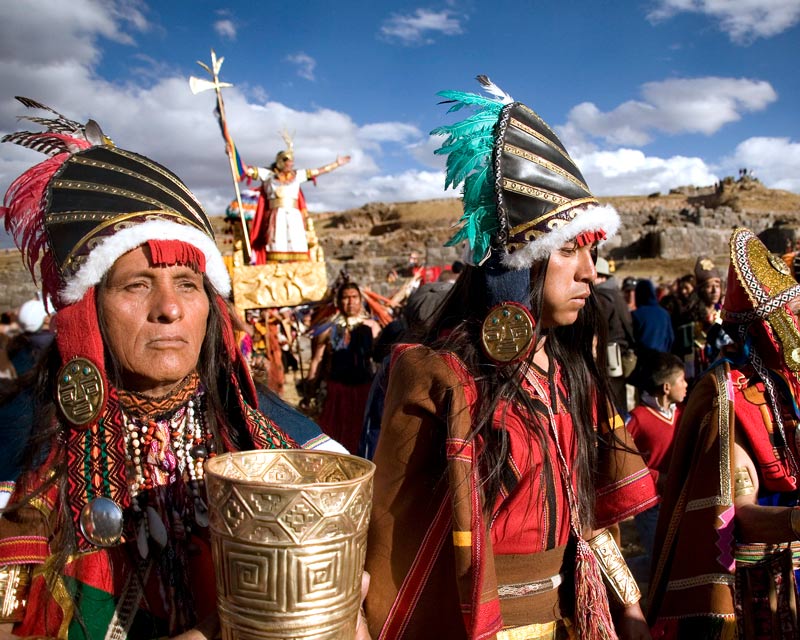The history of Inti Raymi in Cusco
In 1400, the Inca Pachacutec instituted the Inti Raymi ceremony, a sacred celebration in which, with dances, songs in Quechua, sacrifices and offerings, tribute was paid to the sun, as well as called Inti, the main god of the Incas. Can you imagine experiencing firsthand the spiritual and sacred connection that the Incas had with the sun? Learn the history of this great festival that remains alive to this day in the city of Cusco, Peru.
Content:
The history of Inti Raymi

The Inca in the Inti Raymi
- Every June 24, during the winter solstice, in the city of Cusco, former capital of the Inca Empire, approximately 600 local artists dressed in sacred robes and traditional costumes, notable for wearing the seven colors of the rainbow, revive the Inti Raymi ceremony.
- It is believed that Inti Raymi already existed as a religious festival. However, Emperor Pachacutec reorganized Inti Raymi as one of the main Inca ceremonies in the calendar. The other festivities of great religious value were: Cápac Raymi, Situay and Aymoray.
- The purpose of Inti Raymi is gratitude to the sun god ‘Inti’, the main Inca deity. The second was to honor the ancient Inca governors. The third was to bring joy to the Inca people of Cusco, the capital of the Tahuantinsuyo empire.
- In ancient times, the Inti Raymi lasted 15 days, during which time the Inca people worshiped the sun god to thank, and also ask for protection, blessings and prosperity in their crops. Currently, the Inti Raymi in Peru lasts one day, but this day will make your trip to Cusco a unique experience.
- The Inti Raymi celebration lasts a little more than three hours in which each of your senses will be delighted with theatrical performances full of mysticism and spirituality that take place in these three stages of the mythical Inca city: the Coricancha, the Main Square and Sacsayhuamán.
The Inti Raymi in the modern era
After the arrival of the Spanish, Inti Raymi was suppressed, a festival considered pagan by the Spanish in the 16th century. In 1944, the Cusco artist Faustino Espinoza proposed a libretto to be performed by the people of Cusco every June 24. Since that day, Inti Raymi is celebrated by the population of Cusco to this day. Gradually the festival acquired worldwide fame. That day is even declared a non-working holiday in Cusco. The objective is to vindicate the Inca tradition in force among the Andean population to this day.
The Inti Raymi ceremony

The Inti Raymi in the Coricancha
- The journey takes place with the first rays of the sun, filling the Cusco scenes with greater importance for the Inca culture.
- The entire ceremony begins at the Qoricancha temple, a mystical place that was considered the most important temple of the Incas.
- He takes his scepter synonymous with power and addresses everyone in his first speech and in complete Quechua. The people who kneel humbly understand that the festival of the sun has begun.
- After this presentation, a tour begins where the Inca shows all his vigor and power along the paths that his ancestors traveled, carried on his shoulders by his faithful warriors who make their way to reach the next place, the main square.
- There, in Huacaypata, the greatest victories were celebrated, surrounded by palaces, it was the religious and administrative axis of the Inca empire.
- Large masses of people are gathered for the ancestral spectacle, all waiting for the entrance of the Inca.
- The staging occurs through the union of the warriors and the people of Tahuantinsuyo (the four regions together): Chinchaysuyo to the north, Cuntisuyo to the west, Collasuyo to the south and Antisuyo to the east, all in relation to Cusco .
- Through dances to the rhythm of folk music from each region of Tahuantinsuyo, they are presented giving their offerings and worship to the Inca and the sun god.
The Inti Raymi and its stages today

Inti Raymi in the main square of Cusco
- Corikancha Temple
- Sinchi, the general of the Inca army, arrives, followed by the imperial troops and the acllas, women selected for ceremonial roles.
- Then, the T’ika T’aqaqkunas make their entrance, who scatter flowers on the ground as a ceremonial gesture that precedes the arrival of the Inca. At the same time, the Pichaqkunas make their appearance, taking charge of cleaning the ground to the beat of three ancient Andean instruments: pututos, quenas and tinyas.
- Finally, the Inca emperor appears accompanied by his wife, the coya, and the high priest Willaq Umu. To culminate, the Inca and the priest lead the offering ceremony to the sun before heading towards the Main Square of Cusco.
- Cusco Main Square
- You can witness the second part of the ceremony in the Main Square of Cusco, where a central altar is erected.
- The representation begins with the entrance of the sinchi and his personal guard, who make a complete circuit of the square. This military leader directs the entry of the army and the musicians, representatives of the four regions of the Inca empire.
- After a display of music and folk dances that will enchant you with their grace and elegance, the Inca emperor and the coya make their entrance accompanied by the ñustas and young people of the Inca nobility.
- Then, the Inca and the high priest go up to the main altar to lead the ceremony of sacrificing a llama and making the offering of coca leaves in honor of the sun god, Inti.
- Sacsayhuamán Archaeological Park
- The last act of Inti Raymi is the central one and the longest, it takes place on the Sacsayhuamán esplanade and lasts around two hours.
- The presentation begins with the entrance of the sinchi accompanied by the four officers representing the imperial armies. To the sound of an impressive soundtrack composed of drums, pututos, quenas and tinyas, the Inca army, made up of about 400 young people, appears.
- Shielded by a chorus of pututos, the Inca emperor makes his entrance by ascending the usnu, a ceremonial table, to carry out rituals of offerings to the sun in the Quechua language, thus marking the end of the Inti Raymi show.
- Finally, in front of the public gathered in Sacsayhuamán, the army, the nobles, the virgins of the sun, the coya and the Inca retire, closing the event with a majestic farewell.
The Inti Raymi in Sacsayhuamán, the great show in honor of the sun
Sacsayhuamán was the most important Inca fortress, from where you can see the entire city and more than that, it can warn you of the enemy presence. During Inti Raymi, the Cusco people and their visitors are grouped across the small hills that surround the fortress, there is always room for those who the magic of Inti Raymi awaits. Once all the people and the nobility have gathered, they venerate the Inca, who, together with a monologue, begins the last act of this ceremony. Once the dances, the music, and the entire world have ceased, the Inca takes possession of the sacrifice, but not before presenting a small bow for its value. The show includes the representation of the sacrifice of a llama. It lasts 2 hours 30 minutes on average.
Questions and answers
These are the most frequently asked questions and answers regarding the history of the Inti Raymi:
1. How much did the Incas celebrate Inti Raymi?
The Incas celebrated Inti Raymi during the winter equinoxes in the southern hemisphere, that is, between June 20 and 24. In those days the sun (supreme Inca god) was closer to the earth.
2. When was the first Inti Raymi celebrated?
The Inti Raymi already existed since the genesis of the Inca culture. However, it was Emperor Pachacutec in 1430 AD, who modified this festival as one of the most important in the Inca calendar.
3. Who was the Inca who established the Inti Raymi?
Emperor Pachacutec, the builder of Machu Picchu, was the one who established the first great Inti Raymi in the 15th century.
4. Where was Inti Raymi celebrated?
In its beginnings, Inti Raymi was celebrated in sacred places such as Huanacaure Hill, present in the legends of the origin of the Incas. Beginning in the era of Emperor Pachacutec (15th century), it was celebrated in sacred places in the city of Cusco such as Plaza Huacaypata (current Main Square) and Coricancha (Temple of the Sun).
5. In what settings is Inti Raymi celebrated today?
Currently the Inti Raymi is celebrated in the city of Cusco, in three settings considered sacred: the Coricancha esplanade, the Main Square and the Sacsayhuamán fortress.
6. When do the people of Cusco celebrate Inti Raymi?
Today the Inti Raymi festival is celebrated every June 24.
7. Is the Inti Raymi free?
The staging of Inti Raymi is celebrated in three stages: the Coricancha, the Main Square and Sacsayhuamán. In the first two scenarios, entry is free for everyone. In Sacsayhuamán, entry to a seat has a cost.
8. Why did the Inti Raymi disappear in Inca times?
In the 16th century, with the arrival of the Spanish to Cusco, the Inti Raymi festival was punished, eradicating its practice for hundreds of years until its modern celebration in the mid-20th century.
